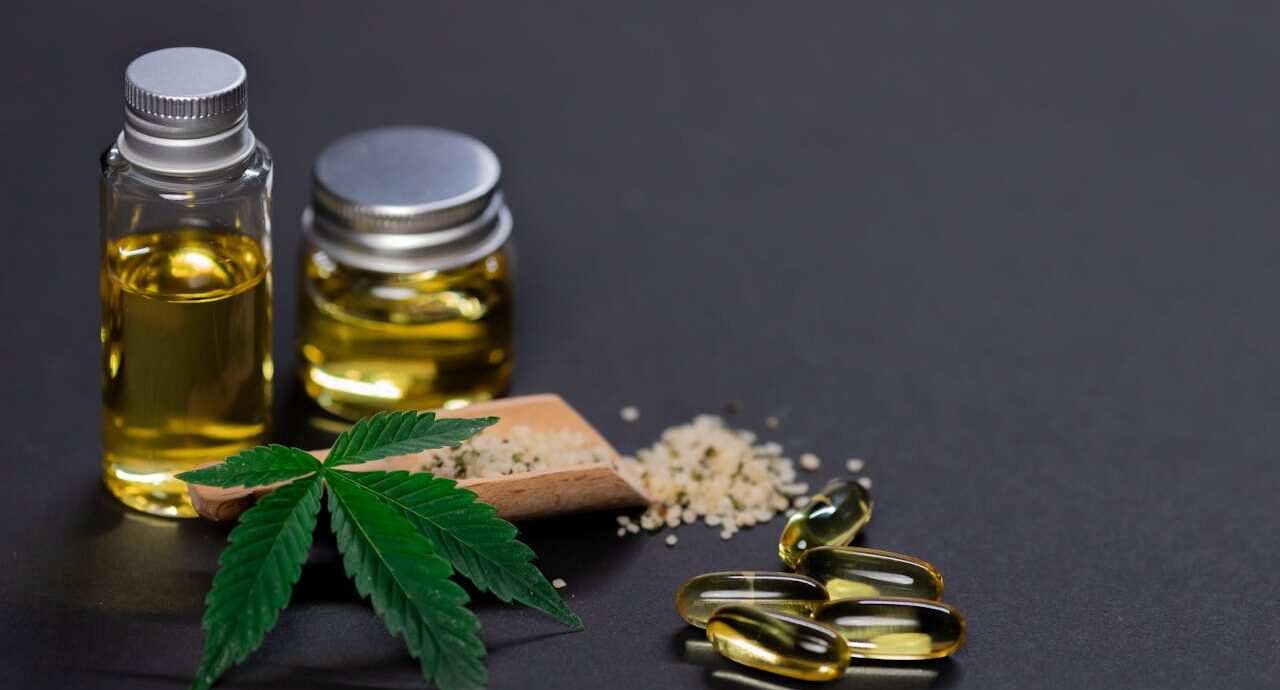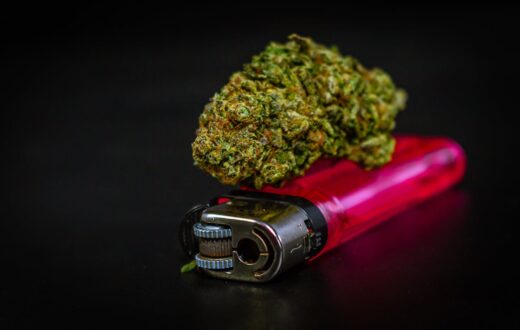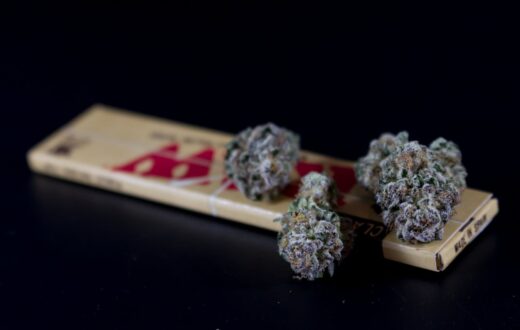Introduction to Alaskan Purple Weed Strain
The Alaskan Purple weed strain is a popular choice among cannabis enthusiasts and cultivators alike, renowned for its distinct characteristics and vibrant appearance. Originating from the northern climates of Alaska, this strain is known for its resilience and adaptability in diverse growing conditions, which makes it particularly appealing to both novice and experienced growers. Its unique genetics typically feature a blend of indica and sativa, resulting in a balanced high that offers relaxing effects with uplifting qualities.
One of the most striking features of the Alaskan Purple strain is its rich violet and purple hues that emerge during the flowering phase. This eye-catching coloration is a result of anthocyanin pigments, and it can be influenced by environmental factors such as temperature and nutrient availability. The visual appeal of this strain does not stop at its color; it is also celebrated for its aromatic profile, which often includes notes of earthiness paired with hints of sweetness and fruit. Growers frequently report a delightful combination of berry-like and piney scents, creating an inviting experience for both cultivators and consumers.
The flavor profile of Alaskan Purple adds to its allure, delivering a smooth, enjoyable smoking experience. Users often describe the taste as sweet and slightly spicy, further enhancing its appeal in both recreational and medicinal contexts. As a result, those seeking to learn how to grow Alaskan purple weed strain often find themselves drawn not only to its impressive features but also to its potential in producing high-quality yields, making it a sought-after addition to any cannabis garden. The Alaskan Purple strain is indeed a cultivation gem that can provide rewarding results with the right care and attention.
Understanding the Genetics of Alaskan Purple
The Alaskan Purple weed strain has garnered attention for its unique characteristics and appealing profile, often making it a popular choice among cannabis enthusiasts. At the heart of this strain’s distinctive features lies its genetic background. Alaskan Purple is predominantly an Indica strain, and its lineage can be traced back to its parent strains, which contribute significantly to its growth characteristics, potency, and overall yields.
One of the key parent strains of Alaskan Purple is Purple Afghani, known for its rich color, robust flavor, and calming effects. This strain’s genetic contributions are evident in the Alaskan Purple’s enchanting purple hues and dense, resinous buds. The other parent could be traced to traditional Alaskan cannabis varieties, which are typically tailored to flourish in colder climates, thereby enhancing the resilience of Alaskan Purple. This hybridization combines the hardiness of these indigenous strains with the appealing aesthetics of Purple Afghani, allowing for optimized cultivation in various environmental conditions.
Understanding the genetics of Alaskan Purple is vital for growers who aim to maximize their cultivation efforts. The strain’s Indica dominance indicates that it may thrive in shorter growing seasons, allowing for faster flowering times compared to Sativa variants. Additionally, knowledge of these genetic traits can help in selecting the best growing mediums, nutrients, and environmental controls that align with Alaskan Purple’s specific needs. By leveraging this genetic understanding, cultivators can optimize factors such as light exposure and water schedules, ultimately leading to enhanced yield and potency.
Given these insights, it becomes clear that grasping the genetic makeup of Alaskan Purple is not only fascinating but also essential for individuals looking to grow this strain successfully. Improving cultivation techniques by aligning them with genetic insights can result in exceptional harvests of this exquisite strain.
Ideal Growing Conditions for Alaskan Purple
Growing Alaskan Purple weed strain successfully requires attention to various environmental factors. Understanding these conditions is crucial for achieving optimal health and maximizing yield. One of the primary considerations is light exposure. Alaskan Purple thrives under full sunlight, ideally receiving 18 hours of light during the vegetative stage. This can be managed by using high-quality grow lights if you are cultivating indoors. As the plants transition to the flowering stage, reducing light to 12 hours promotes healthy flowering and potency.
Temperature is another essential element in cultivating Alaskan Purple. This strain performs best in a temperature range between 70°F and 80°F (21°C to 27°C) during the day. At night, temperatures can drop slightly but should not fall below 60°F (15°C) to prevent stress and damage to the plants. Maintaining a stable temperature and avoiding extreme fluctuations is vital for encouraging robust growth.
Humidity levels should also be closely monitored. Alaskan Purple prefers a relative humidity of around 40-50% during the flowering phase. High humidity can lead to mold issues, which this strain is particularly susceptible to. Employing dehumidifiers or fans can help create a suitable environment. Additionally, the right soil type can significantly impact plant health. Alaskan Purple thrives in a well-draining, nutrient-rich soil, such as a mix of organic compost and perlite. This aids in ensuring that the roots receive adequate oxygen while retaining enough moisture.
Overall, a balanced combination of light, temperature, humidity, and soil type sets the foundation for successfully growing Alaskan Purple weed strain. By maintaining these ideal conditions, growers can enhance the plant’s overall vigor, leading to higher yields and better quality. Understanding and implementing these factors is essential for anyone looking to cultivate this unique strain.
Nutrient Requirements and Feeding Schedule
Successfully cultivating the Alaskan Purple weed strain involves understanding its unique nutrient requirements throughout the various stages of growth. As a hybrid cannabis strain, Alaskan Purple demands a balanced mix of macronutrients and micronutrients to thrive, particularly nitrogen, phosphorus, and potassium, which are essential during different growth phases. During the vegetative stage, an increased nitrogen supply is crucial for leaf and stem development, while the flowering phase requires higher levels of phosphorus and potassium to support bud production and enhance overall potency.
When planning a feeding schedule, it is important to align the nutrient application with the plant’s growth stages. A well-structured feeding schedule typically includes a starter fertilizer rich in nitrogen during the first 4-6 weeks. As the plants transition to the flowering phase, usually around week 6, it is advisable to switch to a bloom fertilizer that provides ample phosphorus and potassium, aiding in the development of heavy, resinous buds. A common feeding routine may involve applying nutrients weekly but always in moderation, allowing the plants to express nutrient uptake fully.
Moreover, monitoring the Alaskan Purple for signs of nutrient deficiencies or excesses is vital. Common deficiency symptoms include yellowing leaves, stunted growth, and poor bud formation, indicating a need for additional nutrients. Conversely, signs of nutrient burn—such as browning leaf tips—suggest that nutrient levels are too high. Adjusting the feeding schedule based on these observations ensures optimal growth. Regular soil testing can also provide insight into the nutrient content and pH levels, helping to maintain a fertile growing environment for this exceptional strain. By adhering to these guidelines, cultivators can successfully learn how to grow Alaskan Purple weed strain and achieve a fruitful yield.
Pest and Disease Management
When cultivating the Alaskan Purple weed strain, understanding the potential pests and diseases that may affect the plants is crucial for successful growth. Alaskan Purple can be susceptible to various pests, including aphids, spider mites, and whiteflies, which can weaken the plants and hinder their development. Additionally, fungal diseases such as powdery mildew and root rot can compromise the health of these plants. Therefore, it is essential to implement effective management strategies to maintain a flourishing crop.
Integrated Pest Management (IPM) offers a comprehensive approach to controlling pests in a sustainable manner. This strategy entails monitoring the growth environment and identifying signs of pest infestations early on. Introducing beneficial insects, such as ladybugs and predatory mites, can help naturally reduce pest populations without the use of harsh chemicals. Furthermore, maintaining proper air circulation and humidity in the growing area can significantly decrease the likelihood of fungal diseases.
Natural remedies can also be effective in managing pests and diseases. Insecticidal soaps or neem oil can be used to deter common pests when applied according to specified guidelines. For fungal issues, the application of a baking soda solution can hinder the spread of powdery mildew. Additionally, regularly inspecting the plants for any irregularities can aid in early detection, enabling prompt action before problems escalate.
Preventative measures are integral to the healthy development of the Alaskan Purple strain. Ensuring that the plants have optimal growing conditions, such as appropriate lighting, temperature, and nutrient levels, strengthens their resilience against pests and diseases. Additionally, practicing crop rotation and maintaining cleanliness in the growing area can significantly contribute to reducing the incidence of potential threats. By embracing these strategies, growers can enhance the overall health and productivity of their Alaskan Purple weed plants.
Pruning and Training Techniques
Pruning and training are critical techniques that can significantly enhance the yield and overall quality of the Alaskan Purple weed strain. Understanding and applying these methods will not only promote healthier plants but also maximize the growth potential of this unique cultivar. One widely used method is topping, which involves cutting off the top of the primary stem. This technique encourages the growth of multiple colas, or flowering sites, promoting a more balanced structure and improving light penetration. By topping the Alaskan Purple, growers can effectively increase its yield, as the plant diverts energy into producing additional bud sites.
Another effective technique is low-stress training (LST). This method entails gently bending and tying down branches to create a wider canopy. By distributing light evenly across all parts of the plant, LST can help achieve a more uniform growth pattern. This is particularly beneficial for Alaskan Purple, as the strain has a tendency to grow tall. Employing LST can help control its height while allowing sunlight to reach lower foliage, ultimately enhancing bud development and weight.
Trellising is also a valuable method for supporting plants as they grow. Installing a trellis system can provide the necessary support to heavy buds, preventing branches from breaking under their weight. This technique is especially useful during the flowering phase of the Alaskan Purple weed strain, as it may experience significant bud growth. Additionally, trellising can help increase airflow around the plants, reducing the risk of mold and pests, which can ruin a harvest. In summary, implementing effective pruning and training techniques will not only bolster the growth of Alaskan Purple but will also lead to a more successful cultivation experience, ensuring that growers can enjoy the maximum potential of this exceptional strain.
Harvesting and Curing Alaskan Purple
The process of harvesting Alaskan Purple weed strain is crucial for ensuring that the final product exhibits optimal potency and flavor. Determining the right time to harvest can significantly influence the overall quality of your yield. Generally, the perfect time to harvest is when the trichomes on the buds have turned from clear to a milky white or amber hue. This indicates peak cannabinoid content and readiness for harvesting.
Once you have determined that it is time to harvest your Alaskan Purple plants, you should carefully cut the branches and remove the larger fan leaves. Utilizing sharp pruning scissors can help in minimizing damage to the plant and ensuring a clean cut. It is advisable to harvest during the early morning or late afternoon when temperature and humidity are optimal, as this can help in preserving terpenes and other valuable compounds present in the buds.
After harvesting, the curing process is essential to enhance the flavor and potency of Alaskan Purple. Begin by hanging the cut branches upside down in a dark, well-ventilated space, maintaining a humidity level of around 50-60%. Allowing the buds to dry for about 7-14 days depending on environmental factors will lead to a more potent and flavorful product. Once the outside of the buds feels dry but the insides are still slightly moist, it’s time to move to the curing phase.
Transfer the dried buds into airtight glass jars, filling them only three-quarters full to allow for air circulation. Store the jars in a cool, dark place, and open them daily for 10-15 minutes to allow moisture to escape and fresh air to enter. Proper curing can take anywhere from two weeks to several months, depending on personal preference. Ultimately, following these steps on how to grow Alaskan Purple weed strain will yield a high-quality product that is rich in flavor and potency.
Common Mistakes to Avoid
Growing the Alaskan Purple weed strain can be an enjoyable and rewarding experience, but several common mistakes can hinder the process and affect the quality of your yield. One of the primary pitfalls is overwatering. Many novice growers tend to think that more water equals healthier plants. However, this can lead to root rot and other moisture-related issues. It is crucial to establish a regular watering schedule while ensuring that the soil drains well and allows for adequate air circulation around the roots.
Another frequent mistake is improper lighting. The Alaskan Purple strain requires a specific light spectrum for optimal growth. Growers may underestimate the importance of light intensity and duration, which can result in stunted growth and lower cannabinoid content. To remedy this, utilizing full-spectrum LED lights or high-intensity discharge lamps can provide the necessary conditions for your plants to flourish. It’s essential to adjust the height of the lights as the plants grow to avoid light burn.
Temperature and humidity levels are also critical factors that some growers overlook. Alaskan Purple thrives in a specific temperature range, typically between 70°F and 85°F during the day and slightly cooler at night. Excessively high temperatures can stress the plants, while too low temperatures can inhibit growth. Additionally, humidity levels should be monitored closely; high humidity can promote mold while low humidity may cause the plants to become dehydrated. Using hygrometers and thermometers can help maintain the appropriate environment.
Lastly, neglecting proper nutrient management can lead to nutrient deficiencies or toxicities. Alaskan Purple requires a balanced mix of macronutrients and micronutrients throughout its growth stages. Use nutrient solutions specifically formulated for cannabis, and follow feeding schedules carefully. In conclusion, by being mindful of these common mistakes, growers can enhance their chances of successfully cultivating the Alaskan Purple weed strain.
Conclusion and Final Tips
In conclusion, successfully cultivating the Alaskan Purple weed strain requires a blend of thorough knowledge, attention to environmental controls, and the right growing techniques. Several key takeaways can help both novice and experienced growers in their endeavors. First, understanding the specifics of the strain is critical; Alaskan Purple thrives in a controlled environment, preferring temperatures that range between 65°F to 75°F. Ensuring adequate light exposure, whether through natural sunlight or artificial grow lights, is vital to promote robust growth. Balance is key, as the intense color and taste that characterize this strain are birthed from a healthy mix of nutrients, including nitrogen, phosphorus, and potassium.
Moreover, regular monitoring for pests and diseases will safeguard the plants as they progress through various growth stages. This strain is known for its resilience, yet vigilance is necessary to prevent any setbacks. Growers should also consider sticking to organic growing methods where possible, as these can enhance the plant’s overall quality and flavor profile. Maintaining proper humidity levels between 40-60% can also significantly influence growth outcomes.
Finally, patience is paramount when growing Alaskan Purple weed strain. The flowering phase typically spans from 8 to 10 weeks, and the results are well worth the wait. As a grower, it is crucial to remain motivated and persistent, learning from any challenges encountered along the way. Each cultivation experience can contribute valuable knowledge for the next attempt. By adhering to these guidelines and embracing the growing journey, cultivators are sure to enjoy a successful harvest of the stunning Alaskan Purple strain.














